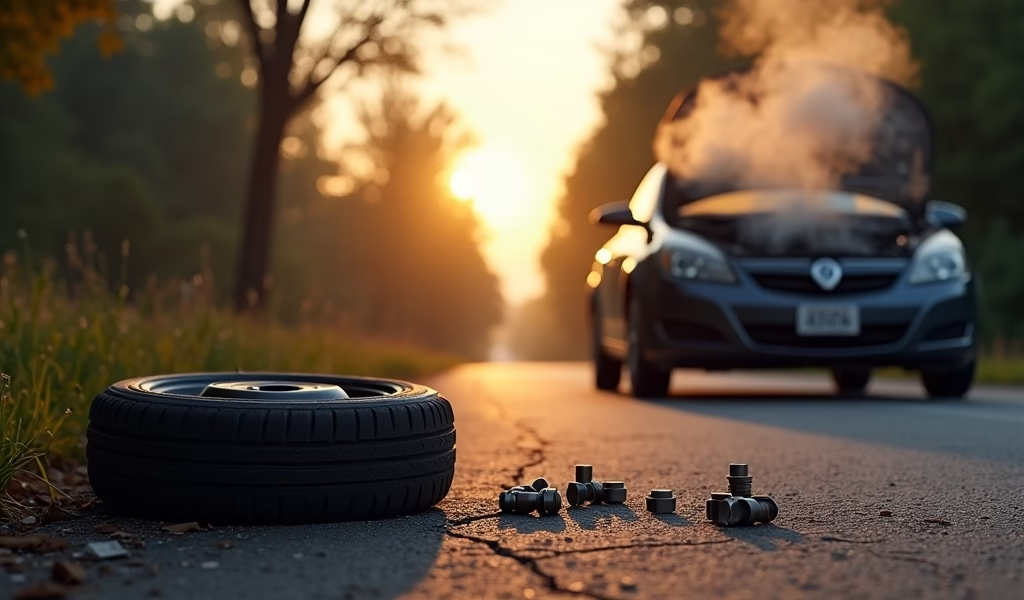Overview
This guide covers five DIY car repairs that save money: replacing air filters, changing oil, maintaining batteries, replacing brake pads, and fixing minor body damage. By learning these skills, car owners can save $400-$1,000 annually while developing a deeper connection with their vehicles, though safety should remain the priority when deciding which repairs to attempt independently.
Table of Contents
- Introduction
- Replacing Air Filters: The Lungs of Your Vehicle
- Changing Oil and Oil Filter: The Lifeblood of Your Engine
- Battery Maintenance and Replacement: Powering Your Journey
- Brake Pad Replacement: Safety You Can Count On
- Fixing Minor Body Damage: Looking Good For Less
- Conclusion: Your Path to Car Care Independence
- Frequently Asked Questions
Watching a mechanic’s bill climb higher than Mount Everest can feel like a direct hit to your wallet. With professional repair costs continuously rising, many vehicle owners are discovering the benefits of DIY solutions. The good news? You don’t need ASE certification to handle many common car issues. With some basic knowledge, a few tools, and a free afternoon, you can save hundreds on essential car maintenance while developing a deeper connection with your vehicle.
Think of your car as a loyal companion that occasionally needs some tender loving care. When you understand what makes it tick, you gain confidence and save money simultaneously. Let me guide you through five affordable car repair tips that can keep your ride running smoothly without emptying your bank account.
Replacing Air Filters: The Lungs of Your Vehicle
Your car’s air filter functions as its respiratory system – when clogged, performance suffers across the board. A dirty filter can reduce fuel efficiency by up to 10%, according to the U.S. Department of Energy, essentially burning your money with every mile driven.
Most manufacturers recommend replacing air filters every 15,000-30,000 miles, but this varies based on your driving environment. If you frequently travel dusty roads or live in a high-pollution area, you’ll need more frequent replacements.
The DIY process couldn’t be simpler:
- Locate the air filter housing (typically a black plastic box under the hood)
- Unfasten the clips or screws securing the housing
- Note how the old filter sits before removing it
- Replace with a new filter in the exact same position
- Secure the housing back in place
The cost comparison is eye-opening. While a new filter costs $10-20, having a shop do this simple job can run $40-100. The time commitment? Just 5-10 minutes with no special tools required – just your hands and perhaps a screwdriver. This repair gives you the most bang for your buck in the DIY world.

Changing Oil and Oil Filter: The Lifeblood of Your Engine
Oil changes are to cars what water is to humans – absolutely essential for survival. Fresh oil keeps engine components properly lubricated, prevents overheating, and significantly extends your vehicle’s lifespan. It’s one of the most fundamental aspects of how to maintain your car properly.
You’ll need some basic materials:
- Oil drain pan
- Wrench for the drain plug
- Oil filter wrench
- New oil filter
- Fresh motor oil (check your owner’s manual for the correct type and amount)
- Funnel
- Gloves
The process isn’t complicated, but it does require getting a bit dirty:
- Warm up your engine for about 5 minutes to help oil flow better, then turn it off
- Locate the oil drain plug underneath your car and place the drain pan below
- Unscrew the drain plug and let the oil flow completely (about 5-10 minutes)
- Remove the old oil filter using an oil filter wrench
- Apply a small amount of fresh oil to the gasket of the new filter
- Install the new filter (hand-tight only) and replace the drain plug
- Add fresh oil through the oil filler cap on top of the engine
- Check the dipstick to ensure proper oil level
Environmental responsibility is crucial – take used oil to an auto parts store, recycling center, or service station that accepts oil for recycling. Never pour it down drains or on the ground!
The potential savings are substantial: DIY costs run $25-45 for oil and filter, while service centers charge $50-100. Do this job 3-4 times per year, and you’ve saved enough for a nice dinner out.
Battery Maintenance and Replacement: Powering Your Journey
Like the morning coffee that gets you going, your car’s battery provides the vital jolt of electricity needed to start your adventure. A well-maintained battery typically lasts 3-5 years, while a neglected one might leave you stranded when you least expect it.
Watch for these warning signs of battery problems:
- Slow engine crank when starting
- Dimming headlights, especially at idle
- Battery warning light illuminated
- Electrical components acting erratically
- Battery older than 3 years
Simple terminal cleaning can extend battery life and improve performance:
- Disconnect the negative (black) terminal first, then positive (red)
- Mix a tablespoon of baking soda with water to create a paste
- Use an old toothbrush to scrub away corrosion
- Rinse with a small amount of water and dry thoroughly
- Reconnect terminals (positive first, then negative)
- Apply petroleum jelly to terminals to prevent future corrosion
Most auto parts stores will test your battery for free, or you can purchase an inexpensive multimeter to check voltage yourself. A healthy battery should read around 12.6 volts when the engine is off.
When replacement becomes necessary, the process is straightforward:
- Identify battery size and type before purchasing a replacement
- Disconnect terminals (negative first)
- Remove any brackets securing the battery
- Lift out old battery (careful – they’re heavy!)
- Insert new battery in the same position
- Reconnect terminals (positive first, then negative)
- Ensure battery is secure and doesn’t move
The savings are significant: DIY replacement costs $75-200 for a new battery while professional service runs $120-250.
Brake Pad Replacement: Safety You Can Count On
Brakes aren’t just another car part – they’re your lifeline when that distracted driver suddenly swerves into your lane. While brake work might intimidate beginners, replacing pads is actually manageable for DIY enthusiasts with basic mechanical skills.
Safety must come first: Always use jack stands when working under a lifted vehicle, never rely solely on a jack. Work on one wheel at a time to use the other brakes as reference points.
You’ll need these tools:
- Jack and jack stands rated for your vehicle’s weight
- Lug wrench
- C-clamp or brake caliper tool
- Socket set and wrenches
- Wire or bungee cord (to hang the caliper)
- Brake grease
The basic replacement procedure follows these steps:
- Loosen lug nuts while the wheel is still on the ground
- Jack up the car and secure with jack stands
- Remove the wheel completely
- Locate the brake caliper and remove bolts holding it in place
- Suspend the caliper with wire (never let it hang by the brake hose)
- Remove old brake pads and inspect the rotor surface
- Compress the caliper piston using a C-clamp or specialized tool
- Install new brake pads with brake grease on the backs (where they contact the caliper)
- Reinstall the caliper and wheel
- Repeat for remaining wheels
- Pump brake pedal several times before driving to restore proper pedal feel
If you notice pulsation when braking, uneven wear, or deep grooves in the rotor surface, they should be replaced along with the pads. Learning how to replace spark plugs and brake pads are two skills that dramatically reduce maintenance costs.
The cost difference is substantial: DIY runs $30-$150 for pads (all four wheels) while professional service costs $250-$500.

Fixing Minor Body Damage: Looking Good For Less
Small dents, scratches, and beginning rust spots are like wrinkles on your car’s face – they tell stories of adventures past, but sometimes you’d rather keep those stories to yourself. Fortunately, minor body repairs often fall within reach of motivated DIY enthusiasts.
For small, accessible dents, try these approaches:
- Use a plunger on smooth, rounded dents (works better than you might think!)
- Try paintless dent repair kits ($20-50) that work wonders on door dings
- For harder-to-reach areas, try the hot water method: pour boiling water over the dent and push it out from behind
- For plastic bumpers, alternate hot water and cold air from a hair dryer to manipulate the material
DIY paint touch-ups require patience but deliver impressive results:
- Clean the damaged area thoroughly with soap, then alcohol
- Sand gently if necessary (600 grit, then 1000 grit for smoothness)
- Apply primer for exposed metal (thin coats, allowing drying time)
- Use manufacturer-matched touch-up paint (available at dealers or auto parts stores)
- Apply in thin layers, allowing drying time between coats (patience pays off)
- Consider clear coat for a finished, protected look
Rust prevention deserves special attention, especially in humid climates or regions that use road salt. According to Consumer Reports, addressing chips and scratches quickly before rust can form significantly extends your vehicle’s lifespan and preserves its value.
These affordable tools and materials make body work accessible:
- Touch-up paint: $10-20
- Dent repair kit: $15-50
- Sandpaper assortment: $5-10
- Microfiber cloths and polishing compound: $15-25
Know when to call in professionals, though. Deep dents, structural damage, or issues affecting door/hood alignment usually require professional body shop attention.
Conclusion: Your Path to Car Care Independence
By mastering these five DIY repairs, you could save anywhere from $400 to $1,000 annually – enough for a nice weekend getaway or a sizeable contribution to your savings. Understanding your vehicle isn’t just about saving money; it’s about forming a connection with the machine that carries you through life’s journeys.
While these affordable car repair tips can significantly reduce maintenance costs, safety should always come first. If you’re uncertain about a repair, or if it involves critical safety systems beyond your comfort level, don’t hesitate to consult a professional. Modern vehicles are sophisticated machines, and some repairs require specialized diagnostic tools and expertise.
Consider expanding your automotive knowledge through basic car maintenance classes at your local community college, watching reputable tutorial videos online, or purchasing a repair manual specific to your vehicle model. Start with simpler repairs like air filter replacement to build confidence and skill before tackling more complex jobs.
Remember that regular preventative maintenance often eliminates the need for major repairs down the road. The time you invest in learning these skills pays dividends both financially and in the satisfaction that comes from maintaining your own vehicle.
Frequently Asked Questions
What are the most cost-effective car repairs to do yourself?
Oil changes, air filter replacements, and wiper blade installations offer the biggest savings for beginners. These simple maintenance tasks require minimal tools and can save $50-100 each time.
How much money can I save by doing my own car repairs?
The average DIY car owner saves $500-1,000 annually on maintenance costs. Larger jobs like brake replacements can save $200+ per axle compared to shop rates.
What tools do I need to start doing basic car repairs?
Start with a basic socket set, screwdrivers, pliers, jack and stands, oil filter wrench, and torque wrench. This starter kit costs $100-150 and handles 80% of basic maintenance tasks.
Is it dangerous to do my own car repairs?
Basic maintenance like oil changes and filter replacements are very safe when following proper procedures. Always use jack stands when working under vehicles and avoid tampering with safety systems like airbags.
How do I know which repairs I should attempt myself vs. taking to a mechanic?
Consider your skill level, tools available, and the safety implications of the repair. Maintenance items and exterior work are beginner-friendly, while transmission work and computer diagnostics usually require professional attention.


Pingback: Fog Lamp Override Function 7 Pro Tips - knowsyourcar.com